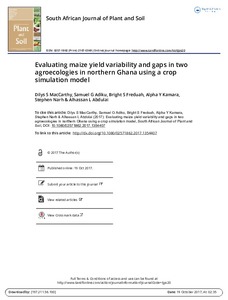| dc.contributor.author | MacCarthy, Dilys S. |
| dc.contributor.author | Adiku, Samuel G.K. |
| dc.contributor.author | Freduah, B.S. |
| dc.contributor.author | Kamara, A.Y. |
| dc.contributor.author | Narh, S. |
| dc.contributor.author | Abdulai, A.L. |
| dc.date.accessioned | 2019-12-04T11:10:51Z |
| dc.date.available | 2019-12-04T11:10:51Z |
| dc.date.issued | 2017 |
| dc.identifier.citation | MacCarthy, D.S., Adiku, S.G., Freduah, B.S., Kamara, A.Y., Narh, S. & Abdulai, A.L. (2017). Evaluating maize yield variability and gaps in two agroecologies in northern Ghana using a crop simulation model. South African Journal of Plant and Soil, 1-11. |
| dc.identifier.issn | 0257-1862 |
| dc.identifier.uri | https://hdl.handle.net/20.500.12478/2285 |
| dc.description | Article purchased; Published online: 19 Oct 2017 |
| dc.description.abstract | The yield gap and variability in maize under smallholder systems in two agroecologies in northern Ghana were evaluated using a decision support system for agrotechnology transfer (DSSAT). The model was used to assess (1) the potential yield of maize (YPOT), (2) water-limited exploitable maize yield (YWEX), (3) nitrogen-limited yield (YNI), (4) farmer practice maize yield (YCFP) and (5) proposed enhanced nutrient use yield (enhanced farmer practice; YEFP). Effect of supplementary irrigation was also assessed on YCFP and YEFP conditions. Yield gaps were determined as the difference between YPOT and YCFP or YEFP on the one hand, and between YWEX and YCFP or YEFP on the other hand. The yield gap based on potential yield ranged from 59% to 75% under CFP and narrowed to between 29% and 59% under EFP. With water-limited exploitable yields, the yield gap ranged from 53% to 65% under CFP, reducing to between 22% and 42% under EFP. The use of supplementary irrigation further reduced the yield gap. Improved fertiliser use and supplementary irrigation have the potential to increase yield and hence reduce the yield gap if effective policies and institutional structures are in place to provide farmers with credit facilities and farm inputs. |
| dc.format.extent | 1-11 |
| dc.language.iso | en |
| dc.subject | Maize |
| dc.subject | Fertilizer Application |
| dc.subject | Crop Simulation Model |
| dc.subject | Yield Variability |
| dc.subject | Yield Gap |
| dc.title | Evaluating maize yield variability and gaps in two agroecologies in northern Ghana using a crop simulation model |
| dc.type | Journal Article |
| dc.description.version | Peer Review |
| cg.contributor.crp | Grain Legumes |
| cg.contributor.crp | Maize |
| cg.contributor.crp | Water, Land and Ecosystems |
| cg.contributor.affiliation | University of Ghana |
| cg.contributor.affiliation | International Institute of Tropical Agriculture |
| cg.contributor.affiliation | Savanna Agricultural Research Institute, Ghana |
| cg.coverage.region | Africa |
| cg.coverage.region | West Africa |
| cg.coverage.country | Ghana |
| cg.isijournal | ISI Journal |
| cg.authorship.types | CGIAR and developing country institute |
| cg.iitasubject | Maize |
| cg.journal | South African Journal of Plant and Soil |
| cg.howpublished | Formally Published |
| cg.accessibilitystatus | Open Access |
| local.dspaceid | 91894 |
| cg.targetaudience | Scientists |
| cg.identifier.doi | http://dx.doi.org/10.1080/02571862.2017.1354407 |

